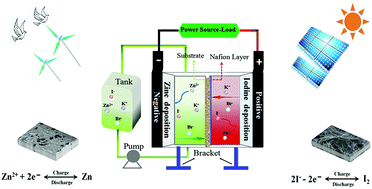Highly stable zinc–iodine single flow batteries with super high energy density for stationary energy storage†‡
Abstract
A zinc–iodine single flow battery (ZISFB) with super high energy density, efficiency and stability was designed and presented for the first time. In this design, an electrolyte with very high concentration (7.5 M KI and 3.75 M ZnBr2) was sealed at the positive side. Thanks to the high solubility of KI, it fully meets the areal capacity of zinc deposition on the negative side. Most importantly, the ZISFB can be charged to nearly 100% state of charge (SOC) or I− can be fully charged to solid state I2 so as to get a maximum energy density. Besides, the blockage of the pump and pipelines on the positive side caused by solid I2 can be inhibited due to the avoidance of electrolyte circulation. Besides, the employment of a highly composite porous polyolefin ion conducting membrane with a super thin Nafion layer effectively improved the membrane selectivity. As a result, the ZISFB demonstrated a CE of 97% and an EE of 81% at a current density of 40 mA cm−2, and the battery could continuously run for more than 500 cycles. The battery demonstrated a high energy density of 205 W h L−1 (theoretical energy density is about 240 W h L−1) (7.5 M KI and 3.75 M ZnBr2 as the electrolyte), which is the highest cycling energy density ever reported. With super high energy density, long cycling life, and a simple structure, a ZISFB becomes a very promising candidate for large scale energy storage and even for power batteries.



 Please wait while we load your content...
Please wait while we load your content...